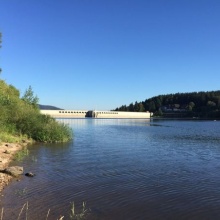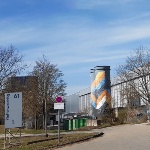Abstract
Reservoirs are major constructions by mankind that serve highly important purposes such as water and energy supply, flood protection, navigable waterways and, ultimately, recreational activities and tourism. In the near future, reservoirs will gain even more significance due to the expected demographic and climate changes, ongoing globalisation and the shift towards green energy such as hydropower.
At the same time, these dam constructions often provoke serious socio-economic tensions, as they come with extensive changes in landscape, disruption of the river continuum and ecological impairments of the adjacent habitats. Moreover, reservoirs accumulate large sediment depositions that are often associated with pollutants, organic material and nutrients, driving eutrophication within the retained lake (e.g. toxic phytoplankton blooms, greenhouse gas production), while downstream regions have inadequate provisions of sediments. As reservoirs age, their functioning is increasingly at stake since deposited sediments reduce their storage capacity and potentially block intake structures and bottom outlets. While there is little flexibility to vary dam construction itself, improving management practises seems the way forward to address all of the aforementioned problems to ensure both, economic operation and ecological resilience.
This research project includes the joint work on the increasingly pivotal issues concerning reservoir functioning and operation as there are ""Sedimentation"" (work package WP1), ""Microbial Biostabilisation"" (WP2), ""Harmful Cyanobacterial Blooms"" (WP3), ""Greenhouse Gases (GHG) and Carbon Storage"" (WP4) as well as ""Societal Implications and Conflicts"" (WP5). Thereby, WP1 will identify key parameters governing fine sediment dynamics to warrant a more realistic understanding on their incipient motion as well as transport and incorporate appropriate algorithms in numerical models to enhance their prediction power. WP2 pursues the significance of biofilm-induced particle binding for resuspension and flocculation at different seasons, locations (from tributaries to various reservoir spots) and operation strategies. To link sediment transport processes and biofilm growth to hydraulic conditions in reservoirs is uncharted territory, but a prerequisite for potential countermeasures to be developed against siltation and the deterioration of water quality. The latter is one of the features that are specifically addressed in WP3 by exploring the physico-chemical and biological conditions favouring cyanobacterial bloom formation. The occurrence of harmful cyanobacterial blooms (HCB) is a serious threat to water usage including recreational activities and the proposed work is geared toward understanding the processes governing HCB formation in reservoirs and to establish potential links to reservoir operation (sediment stabilization), thus providing the basis for future management strategies that help to prevent HCB. WP4 will relate in detail the consequences of reservoir management to the conditions causing GHG production, GHG release from the sediments, and GHG emissions. Inland waters have received vast attention in recent years as an important source of GHG, however, their contributions to the global budgets are under debate. Fluxes and concentrations of CH4 and CO2 will be investigated in reservoirs linking sediment thickness, sediment mobilisation and water level fluctuations to the spatial distribution of GHG gases, while comparing diffusive emissions, ebullition, and emissions in spillways and in turbines over seasonal time scales with high temporal resolution. Significant GHG release could derogate the green image of hydropower and might change policy as well as public opinion and their disposition to other reservoir impairments. WP5 has the highly innovative vision to identify the general interests and risk awareness of different stakeholders and the public concerning reservoirs in order to avoid, solve or minimise potential conflicts by learning from past mitigation strategies, by agreeing on present reservoir operation routines and by changing future approval procedures; all of which have the intension to enhance general acceptance and negotiation outcomes.
As can be quickly ascertained from above, the topics of the different WPs are highly interlaced and as such cannot be investigated via individual projects but demand an integrated approach as projected here. Indeed, this newly founded consortium, comprised of expert partners from Stuttgart, Konstanz und Freiburg crossing disciplinary boundaries of engineering, natural and social science, complementing sedimentology, biology, physics, chemistry, history and conflict analysis, offers a unique holistic view on reservoirs which is fundamental for identifying the critical parameters that need to be addressed urgently in current and future dam management.
Further information about the CHARM project can be found on our website: https://www.charm-bw.de/index.en.html
Project manager
Deputy
Sabine Ulrike Gerbersdorf
Stefan Haun
Research assistants
Duration
From: 2016.01.01
To: 2021.03.31
Finances
Ministerium für Wissenschaft, Forschung und Kunst Baden-Württemberg
Cooperation partners
University of Konstanz - Human and Environmental Toxicology and Limnological Institute
University of Freiburg - Institute for Social-Environmental Studies and Geography



